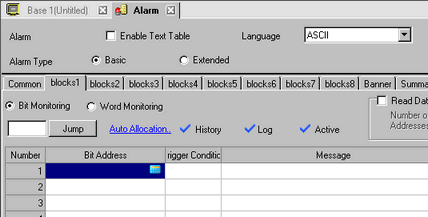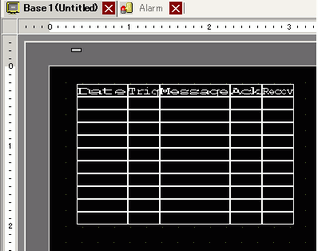This section explains the setting procedure, using a Bit Monitoring example.
When the Monitoring Bit Address turns ON, the Alarms are displayed together with their trigger date/time. When the Monitoring Bit Address turns OFF, the recovery time is added to the same row.
-
From the [Common Settings (R)] menu, select [Alarm (A)], or click  . The following screen appears. In [Language], select the alarm message display language.
. The following screen appears. In [Language], select the alarm message display language.

-
In the Block Settings, select the check box for the desired display mode (History/Log/Active) for the block to which the message is registered, and set the number of messages stored as history for each mode.
-
Select [Backup History] and define [Hide Continuing Alarms].
-
From the [Block1] tab, select [Bit Monitoring].

-
In [Bit Address], set the bit address to monitor the alarm trigger.
-
In the [Trigger Condition] cell, select whether the alarm is triggered when the Monitoring Bit Address turns ON or turns OFF.
-
In the [Message] cell, input the alarm message that will display when the alarm is triggered.

-
Up to 160 single-byte characters can be registered in a single Alarm Message.
-
When the [Enable Text Table] check box is selected, the message language can be switched and displayed even while the system is running.
 18.3 Changing Blocks of Text to Other Languages
18.3 Changing Blocks of Text to Other Languages
-
Select the [Read Data From Each Alarm] check box, and specify [Number of Addresses] (for example, 3) to read the data values.

-
Click the [Address1] cell, then click  . The [Trigger Condition Settings] dialog box appears.
. The [Trigger Condition Settings] dialog box appears.

-
Set the addresses to read the data values when Alarms triggered.
-
Set the value in [Data Display Style], and click [OK].
-
Specify [Bit Length] and [Data Type]. Alarm settings have been completed.
-
Open the screen editor and set the Alarm part which will display the Alarm. In the [Parts (P)] menu, select [Alarm (A)], or click  and place the Part on the screen.
and place the Part on the screen.

-
Double-click the placed Alarm. The Alarm dialog box appears.

-
For the alarm, select the Block and the Display Mode.
-
Set the [Display Start Row], [Display Alarms] and [Display Row Spacing].
-
On the [Item] tab, select the [Address] check box to set [Display Characters]. Select the [Address1], [Address2], and [Address3] check boxes.

-
As needed, use the [Color] tab, and [Display] tab options to change alarm message's number of display characters, text color, background color, font, and size. Click [OK].
![]()
 20.12.1.2 Alarm Settings (Block 1) - Bit Monitoring
20.12.1.2 Alarm Settings (Block 1) - Bit Monitoring 20.12.2.1 Show History - Basic Settings/Basic
20.12.2.1 Show History - Basic Settings/Basic 8.7.1 Editing Parts
8.7.1 Editing Parts





